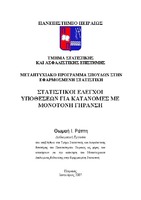Στατιστικοί έλεγχοι υποθέσεων για κατανομές με μονότονη γήρανση

Master Thesis
Author
Ράπτη, Θωμαή Ι.
Date
2007-05-16View/
Abstract
In the present MSc Dissertation we examine reliability classes with monotone aging. The first part of the thesis demonstrates the most familiar classes as well as their attributes while the second one, examines the statistical issue of testing hypothesis for distributions with monotone aging. In the first chapter, we introduce the concept of the failure rate of a unit or a system. Initially, we demonstrate its definition and interpretation. Finally, we present known parametric models and examples for the failure rate for each distribution with analytical presentation of the form and the graph of both the failure rate and the reliability function. In the second chapter, we study various families of distributions that are being classified by the failure rate or the mean residual life. Each class is being comprehensively studied by stating several propositions that give the connection with other reliability classes. In the third chapter, we study the methodology that has been proposed over the last years and concerns the test of hypothesis that a distribution has a monotone aging. In these controls, the null hypothesis is that the examined distribution is exponential, with constant failure rate, while the alternative hypothesis is that this distribution belongs to a non-parametric class of distributions (i.e IFR, IFRA, NBU, NBUE, etc). In the fourth chapter, we approach the issue of the statistical controls that had been studied in the previous chapter, through its practical aspect and specifically via simulation. By using the statistical package “Mathematica”, we produce random samples from distributions that we use in reliability theory- such as Weibull, Gamma, LFR, etc. Then, we estimate the force of the statistic in order to decide whether or not the statistic that we used, leads to statistically significant results and also to empirically estimate the efficiency of the particular statistical method.


